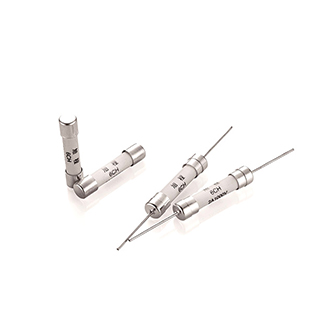
Ceramic gas discharge tubes are the most widely used switching devices in lightning protection equipment. Whether it is for lightning protection of AC and DC power supplies or various signal circuits, they can be used to discharge lightning currents into the ground. Its main characteristics are: high discharge current, small interpole capacitance (≤ 3pF), high insulation resistance (≥ 109 Ω), high dispersion of breakdown voltage (± 20%), and slow reaction speed (the fastest is 0.1-0.2 μ s) . According to the number of electrodes, there are two types of discharge tubes: bipolar discharge tubes and bipolar discharge tubes (equivalent to two bipolar discharge tubes connected in series). Its shape is cylindrical, with two structural forms: with and without leads (some also have protective cards for short circuits in case of overheating).
A gas discharge tube consists of two electrodes enclosed at a certain distance in a ceramic tube filled with inert gas. Its electrical performance basically depends on the type of gas, gas pressure, and electrode distance. The gas filled in the middle is mainly neon or argon, and a certain pressure is maintained. The electrode surface is coated with an emitter to reduce electron emission energy. These measures enable the action voltage to be adjustable (usually from 70 volts to several thousand volts) and can be maintained within a certain error range. When the voltage at both ends is lower than the discharge voltage, the gas discharge tube is an insulator (resistance Rohm>100M Ω). When the voltage at both ends increases to greater than the discharge voltage, an arc discharge is generated. After gas ionization discharge, the high impedance changes to low impedance, causing a rapid decrease in the voltage at both ends, approximately several tens of volts. When a gas discharge tube is subjected to transient high-energy shocks, it can convert the high impedance between its two poles into low impedance at a speed of 10 to 6 seconds, passing through surge currents of up to tens of thousands of amperes.
Used in the common mode circuit of power lightning arrester to discharge lightning current into the ground, or can be connected in series with a varistor in a differential mode circuit to block its leakage current. In signal lightning protection devices, the first stage is often used to release surge current. Due to its slow response speed, the second stage is also used as voltage limiting protection. Ceramic gas discharge tubes belong to switch components, and the voltage at both ends during conduction is very low, so they cannot be directly used for differential mode protection in active circuits. When necessary, current limiting components should be connected in series to prevent damage or even fire caused by excessive current during conduction; After the surge, it can be restored to an open circuit state.
Read recommendations:
coffee maker thermostat replacement
How to install a fuse for 220V
5 * 20 quick break glass tube fuse with lead wire.ceramic test fuse